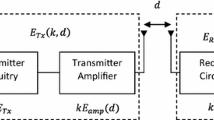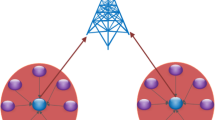Abstract
As a result of the increased demand of wireless sensor networks (WSNs) reliability, classical clustering protocols that assume all the nodes have the same amount of energy cannot take full advantage of the presence of heterogeneity. In this paper, a Stable and energy efficient clustering protocol for heterogeneous WSNs is proposed. It depends on the network structure that is divided into clusters. Each cluster has a powerful advanced node (AN) and some of normal nodes (NNs). The NNs make the sensing operation; AN then aggregates all data coming from its cluster and transmits them to the base station. The optimum number of ANs and the required energy for them with respect to the NNs are analytically obtained in order to guarantee minimum energy consumption of the network. The performance of the proposed protocol is compared by the existing homogeneous and heterogeneous protocols. Simulation results show that the proposed protocol provides more energy efficiency and stability than the existing protocols.








Similar content being viewed by others
References
Rizk, R. (2013). Quality of services in wireless sensor networks. in wireless sensor networks: From theory to applications. In Ibrahiem M.M. EI Emary & S. Ramakrishnan (Eds.). CRC Press, Taylor & Francis Group, USA. http://www.crcpress.com/product/isbn/9781466518100.
Zonouz, A. E., Liudong, X., Vokkarane, V. M., & Sun, Y. L. (2014). Reliability-oriented single-path routing protocols in wireless sensor networks. IEEE Sensors Journal, 14(11), 4059–4068.
Katiyar, V., Chand, N., & Soni, S. (2011). A survey on clustering algorithms for heterogeneous wireless sensor networks. International Journal of Advanced Networking and Applications, 2(4), 745–754.
Al-Karaki, J. N., & Kamal, A. E. (2004). Routing techniques in wireless sensor networks: A survey. Wireless Communications Journal IEEE, 11(6), 6–28.
Rizk, R., Elhadidy, H., & Nassar, H. (2011). Optimized mobile radio aware routing algorithm for wireless sensor networks. IET Wireless Sensor Systems, 1(4), 206–217.
Pantazis, N. A., Nikolidakis, S. A., & Vergados, D. D. (2013). Energy-efficient routing protocols in wireless sensor networks: A survey. IEEE Communications Surveys and Tutorials, 15(2), 551–591.
Tang, L., Feng, S., Hao, J., & Zhao, X. (2015). Energy-efficient routing algorithm based on multiple criteria decision making for wireless sensor networks. Wireless Personal Communications, 80(1), 97–115.
Rizk, R., Magdy, S. M., & Zaki, F. W. (2015). Energy efficiency of virtual multi-input, multi-output based on sensor selection in wireless sensor networks. Wireless Communications and Mobile Computing, 15(1), 1–15.
Amgoth, T., & Jana, P. K. (2015). Energy and coverage-aware routing algorithm for wireless sensor networks. Wireless Personal Communications, 81(2), 531–545.
Kumar, D. (2014). Performance analysis of energy efficient clustering protocols for maximising lifetime of wireless sensor networks. IET Wireless Sensor System, 4(1), 9–16.
Rehman, O., Javaid, N., Manzoor, B., Hafeez, A., Iqbal, A. & Ishfaq, M. (2013). Energy consumption rate based stable election protocol (ECRSEP) for WSNs. In Procedia computer science (Vol. 19, pp. 932–937). Elsevier.
Peng, J., Liu, T., Li, H. & Guo, B. (2013). Energy-efficient prediction clustering algorithm for multilevel heterogeneous wireless sensor networks. International Journal of Distributed Sensor Networks, 9(2), 1–8.
Heinzelman, W. B., Chandrakasan, A. P., & Balakrishnan, H. (2002). An application specific protocol architecture for wireless microsensor networks. IEEE Wireless Communications, 1(4), 660–670.
Tang, L. & Li, Q. (2009). S-SPIN: A provably secure routing protocol for wireless sensor networks. In Proceedings of international conference on communication software and networks, (ICCSN), China (pp. 620–624).
Ali, M. S., Dey, T. & Biswas, R. (2008). ALEACH: Advanced LEACH routing protocol for wireless microsensor networks. In Proceedings of 5th international conference on electrical and computer engineering (ICECE), Bangladesh (pp. 909–914).
Guo, L. Q., Xie, Y., Yang, C. H. & Jing, Z. W. (2010). Improvement on LEACH by combining adaptive cluster head election and two-hop transmission. In Proceedings of the international conference on machine learning and cybernetics (ICMLC), Hong Kong (pp. 1678–1683).
Tuah, N., Ismail, M., & Jumari, K. (2012). Energy-efficient improvement for heterogeneous wireless sensor networks. Information Technology Journal, 11(12), 1687–1695.
Smaragdakis, G., Matta, I., & Bestavros, A. (2004). SEP: A stable election protocol for clustered heterogeneous wireless sensor networks. In Proceedings of 2nd international workshop on sensor and actuator network protocols and applications (SANPA), Boston, USA (pp. 1–11).
Kashaf, A., Javaid, N., Khan, Z. A., & Khan, I. A. (2012). TSEP: Threshold-sensitive stable election protocol for WSNs. In Proceedings of 10th IEEE international conference on frontiers of information technology (FIT), Pakistan.
Li, X., Huang, D., & Sun, Z. (2007). A routing protocol for balancing energy consumption in heterogeneous wireless sensor networks. Mobile Ad-Hoc and Sensor Networks (MSN), 4864, 79–88.
Aderohunmu, F. A., Deng, J. D. & Purvis M. K. (2011). A deterministic energy-efficient clustering protocol for wireless sensor networks. In Proceedings of 7th international conference on intelligent sensors, sensor networks and information processing (ISSNIP), Adelaide, Australia (pp. 341–346).
Qing, Li, Zhu, Qingxin, & Wang, Mingwen. (2006). Design of a distributed energy-efficient clustering algorithm for heterogeneous wireless sensor networks. Computer Communications, 29(12), 2230–2237.
Saini, P., & Sharma, A. K. (2010). Energy efficient scheme for clustering protocol prolonging the lifetime of heterogeneous wireless sensor networks. International Journal of Computer Applications, 6(2), 30–36.
Elbhiri, B., Saadane, R., & Aboutajdine, D. (2009). Stochastic distributed energy-efficient clustering (SDEEC) for heterogeneous wireless sensor networks. ICGST-CNIR Journal, 9(2), 11–17.
Kumar, D., Aseri, T., & Patel, R. B. (2009). EEHC: Energy efficient heterogeneous clustered scheme for wireless sensor networks. Computer Communications, 32, 662–667.
Han, L. (2010). LEACH-HPR: An energy efficient routing algorithm for heterogeneous WSN. In Proceedings of IEEE international conference on intelligent computing and intelligent systems (ICIS), China (Vol. 2, pp. 507–511).
Author information
Authors and Affiliations
Corresponding author
Rights and permissions
About this article
Cite this article
Rizk, R., Farouk, F. & Zaki, F.W. Towards Energy Efficiency and Stability in Heterogeneous Wireless Sensor Networks. Wireless Pers Commun 96, 4347–4365 (2017). https://doi.org/10.1007/s11277-017-4390-1
Published:
Issue Date:
DOI: https://doi.org/10.1007/s11277-017-4390-1




